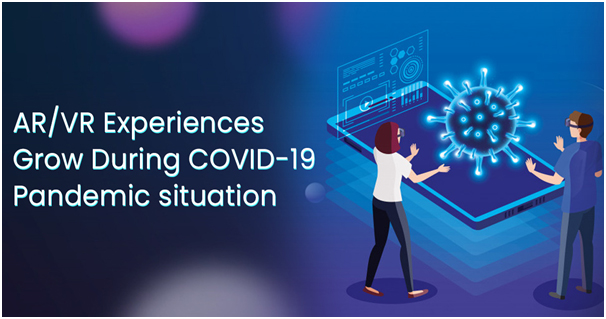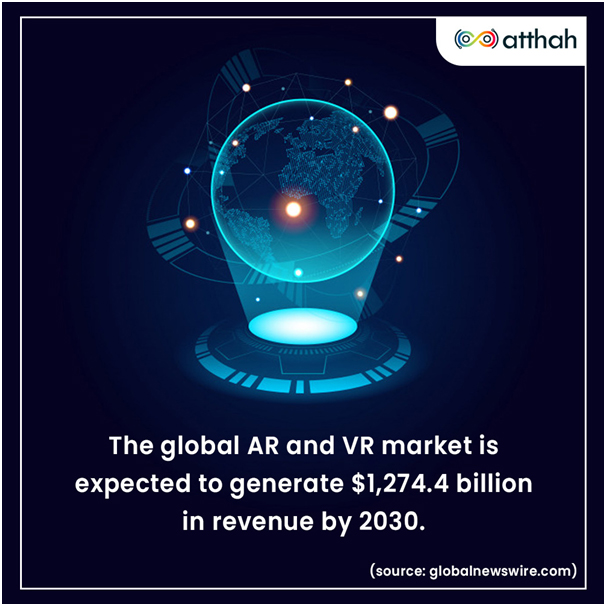AR/VR Experiences Grow During COVID-19 Pandemic situation
As the COVID-19 pandemic has spread throughout the world, governments, organizations, and businesses have increasingly turned to virtual and augmented reality technology to allow the homebound population to experience tours of national parks, museums, the International Space Station, and major cities.
Anything from museums and parks to hotels and communities is now displaying realistic 360-degree images and videos of their spaces thanks to augmented reality (AR) and virtual reality (VR) technologies. Once the pandemic ends, top tourist attractions and advertisers will employ AR/VR to persuade tourists with a try-before-you-buy strategy.
The global market for augmented reality (AR) and virtual reality (VR) market is forecasted to generate $1,274.4 billion in revenue by 2030, up from $37.0 billion in 2019. The market is forecasted to grow at a robust CAGR of 42.9% over the projected period (2020-2030). (Source: Globalnewswire.com)
Market Growth
The AR market is growing due to rising demand for AR devices and applications in healthcare, soaring investments in the AR market, and increasing demand for AR in the retail and e-commerce sectors due to COVID-19.
The availability of affordable VR devices, the adoption of HMDs in various industries, technological advancements and digitization, penetration of HMDs in gaming and entertainment sectors following COVID-19, and high investments in the VR market are the main factors driving the VR market development. Some of the restrictions include security and privacy concerns associated with AR & VR and health issues are linked with improper use of AR and VR.
As per the forecast, consumer applications are expected to retain their market dominance in augmented reality
In 2020, the consumer application is expected to have the largest share of the AR market, and it will continue to do so during the forecasted period. Gaming and entertainment technologies are used in the consumer field, with AR being used in games, to create 3D visual objects in the real world. The gaming, sports and entertainment industries are experiencing rapid growth, which is ultimately boosting the AR demand for consumer applications.
In virtual reality, enterprise applications are expected to evolve at the fastest rate during the forecast era
In the manufacturing sector VR is usually used for staff training, providing knowledge about the industrial plant, remodeling& redesigning, and industrial simulations. In industrial applications, Head Mounted Displays (HMDs) are used for design, training, and simulation. Industry users can be educated in efficiently using HMDs in hindsight to learn real-world activities in an immersive and interactive virtual environment. In the coming years, the use of HMDs is expected to increase in several industries.
North America will account for a sizeable portion of the market
North America is home to key players in the AR & VR market, including Google (US), PTC (US), Microsoft (US), Oculus (US), and Apple (US), which is a significant contributor to the region's AR & VR market growth. The increasing use of smartphones, the adoption of smart electronic devices, and the rising demand for AR and VR technology in healthcare applications are all stimulating the North American AR and VR market forward.
Due to the high demand for AR & VR devices in the area and the emergence of local manufacturers in China, these devices get leveraged at a low cost. APAC is expected to lead the AR & VR market by 2025. The growing use of HMDs in the healthcare and enterprise sectors is also likely to boost market players in APAC.
Market Trends
Some promising opportunities for the AR sector are by telecom companies & AR manufacturers are forming partnerships to reduce latency to undetectable levels, rise in demand for architecture sector and high growth of travel & tourism industry. The limitations of AR are overcoming social challenges to Increase Adoption Rates, restructuring applications for different platforms, and display latency.
The VR sector has witnessed some opportunities like HMD inclusion in healthcare and architectural applications, training & simulation of virtual reality in aerospace and defense and, Covid-19 has also scaled up the demand for VR HMDs in the healthcare sector. Challenges are the creation of user-friendly VR systems and the untoward impact of lockdown on business.
Conclusion
COVID-19 pandemic provides a glimpse into the many possibilities of VR and AR. The underlying technologies have been evolving for some time and will continue to do so. Given the forms in which virtual environments provide additional comfort and independence in the current situation, participation is likely to increase once the uproar dies down.
Source links:
https://www.businesswire.com/news/home/20210111005575/en/Augmented-Reality-and-Virtual-Reality-Market-with-COVID-19-Impact-Analysis---Global-Forecast-to-2025---ResearchAndMarkets.com
https://www.designnews.com/electronics/arvr-experiences-grow-during-covid-19
Contact Us
Sometimes magic is just someone spending more time on something than anyone else might reasonably expect.
Just a call away
Available: Mon-Sun 24 | 7
Atthah Info Media Pvt. Ltd.
Gurugram,
Haryana, India - 122001
+91 124 426 2229
+91 998 333 2229
For more details, just contact us at ask@atthah.com
Copyright © 2025. Atthah Info Media Pvt. Ltd. All Rights Reserved.

